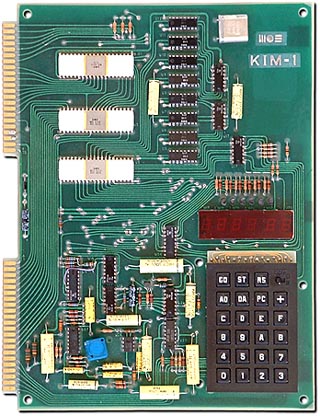
Posted on 05/18/2016 10:21:45 AM PDT by dayglored
The 6502 CPU is a fondly-remembered CPU* for good reason: along with chips from Motorola, Intel and Zilog, it helped create the personal computer business in the 1980s.
However, this project is affection on a grand scale: some US enthusiasts are creating a transistor-for-transistor replica of the chip's design using discrete components.
It's a good thing we're in the era of surface mount components, because even with small components the 3,218 transistors, 1,019 resistors and various other bits of the MOnSter 6502 need a four-layer PCB measuring 12” x 15” with components mounted on both sides.
Because a big, slow, and mostly-useless processor board would be boring without flashing lights, it also includes 167 LEDs showing the values of “various control lines, registers, and status bits”.
Why do it? You could take a hint from the interests of one of the designers, Eric Schlaepfer, a vacuum tube enthusiast. He worked with Windell Oskay of Evil Mad Scientist Laboratories to design the MOnSter 6502.
Schlaepfer writes that other 6502 enthusiasts had already done the hardest work of reverse-engineering the innards of the chip:
“The hard work of reverse engineering the actual 6502 has already been done by the folks at Visual6502.org. I was able to extract the netlist from their Javascript simulation, which contains a list of all the transistors and every single wire connecting them together”.The enormous board – the name MOnSter 6502 is a play on the original MOS 6502 chip – will be on display at the 2016 Bay Area Maker Faire.
Regrettably, the chip won't be able to completely emulate the original 6502 inside an olde-worlde Apple board, because it's too slow.
The huge amount of capacitance on the board means its clock will probably max out between tens and hundreds of kilohertz. That might be enough, however, to get it to boot and run BASIC, Schlaepfer hopes.®
*Schlaepfer and Oskay like their disaggregated chips. They've also recreated discrete-component versions of two smaller classics: the 555 timer, and the 741 op-amp.
Tech and Apple ][ Pings?

The 6502 and its derivatives drove the home computer market.... yes a few z80 based machines existed, but the vast majority of the early personal computer market were 6502 based.... In fact they still manufacture an ancestor of this chip, it is used extensively to this day in various ways...
http://westerndesigncenter.com/wdc/w65c02s-chip.cfm
I was a Z-80/CPM guy, m’self:
Coleco Adam
Tandy/Radio Shack TRS-80 Model I
Spectravideo SV-318
Kaypro II
Osborne I
Timex 2000
Z80 rocked.
Add the Sequa Chameleon to your list. Had the 8088 and Z80.
I remember the Alrair 8800 (1975)
With the mighty Intel 8080
https://en.wikipedia.org/wiki/Intel_8080

I used to work on an 80 era Texas Instruments system built for the military. The CPU was 48K memory all with dip chips. Special 15 bit microprocessor (I am not making this up). The normal current draw was 40 amps. It was a two man lift to carry it around.
using SMT seems like cheating...
OMG. This reminds me of folks who build clocks out of NIXIE tubes. Yeah, OK, they are kinda cool.
When you can buy an LED clock new for $7 which is what each digit of a clock in Nixie costs......never mind wiring the things together....
Or you can buy an LED clock in a thrift store for $2.
Odd numbers of bits was de rigeur in many customer processors, even DEC built PDPs ranging from 12 go 36 bits. And the bit-slice CPUs like the AMD 2900 family gave you whatever you wanted, in 4 bit increments.

Keyboard Input Monitor aka KIM-1. A sweetheart of minimalism.
Well, everyone knew of the Altair, but I didn’t find the thing interesting until I read an article on the CompuColor, which sported the 8080A. I also helped key in Teeny BASIC for a fellow who built his own 10K Z80 computer back in the ‘80s, hooked up to a 9” Sanyo B/W Monitor with a raw keyboard with no case. The fellow went to Harvard and on to found his own dot-com in Massachusetts.
My pal at the time who also helped key in Teeny BASIC, wanted an Exidy Sorcerer. I went for color, he went for hi-res (768x256 B/W) and the Sorcerer had a Z-80 processor.
Then I stepped up to a Motorola 68000.
In other words, Woz really was a wiz.
I’m surprised they didn’t find a way to work in legos and ball bearings/water clock mechanisms there...
“And the bit-slice CPUs like the AMD 2900 family gave you whatever you wanted, in 4 bit increments.”
These were used in Atari vector games like Red Baron, Battlezone, and Tempest :-). They were a hardware accelerator that handled all of the matrix math for scaling, zooming, and rotations while a 6502 ran the show :-).
Disclaimer: Opinions posted on Free Republic are those of the individual posters and do not necessarily represent the opinion of Free Republic or its management. All materials posted herein are protected by copyright law and the exemption for fair use of copyrighted works.